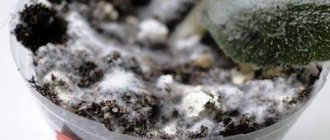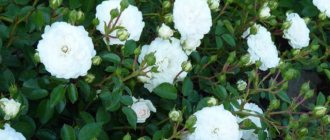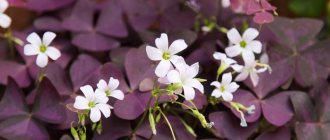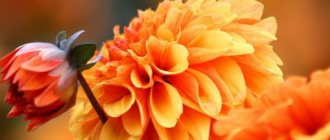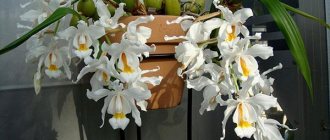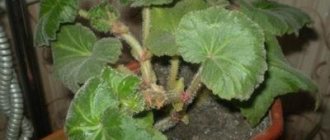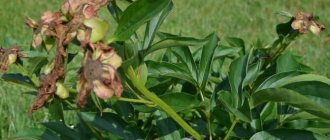Dahlias are luxurious flowers on a tall stem that bloom at the end of summer and delight the eye for a long time. There are many legends about this plant, according to one of which, the flower grew after the Ice Age, on the site of a extinct fire.
The historical homeland of this plant is Mexico. There, dahlias grew in mountainous areas. The Aztecs used their tubers for food; in Europe, dahlias did not receive recognition as a food product, but their beauty was recognized here.
Characteristics of dahlias: varieties and varieties
The culture can be roughly divided into annual dahlias (planted in flowerpots to decorate verandas) and perennial dahlias (placed in gardens and flower beds). Each group has its own characteristics, which relate to the principle of planting, appearance and care.
Blooming dahlias
Important! Basically, the difference lies only in the parameters of the aerial parts and buds.
Perennial bushes are very tall and lush. They can grow in one place for more than 2 years. Annuals have miniature forms (usually a low-growing herbaceous base) and are sown as a temporary decoration.
Varieties of varieties
Another difference is the shape of the flower, which determines the main groups of varieties:
- Simple - consist of 1 row of petals and an open center. Outwardly they resemble a colored chamomile. Basic varieties: Princess Marie Jose, Yellow Hammer, Orangeade.
- Anemone-shaped - have several rows of marginal and internal petals. They include varieties such as Lucy, Vera Higgins, Comet.
- Collared - have one row of marginal petals and internal, twisted shape. Varieties: La Gioconda, Chimborazo, Claire de Luna.
- Peony-shaped. The name fully matches the appearance. The most popular varieties are: Symphonia and Fascination.
- Decorative group - represented by varieties David Howard, Thames Valley, Jocondo.
- Globular - Crichton Honey, Doreen Hayes and Esmonde.
- Pom-poms - differ in different colors, among which there is only a blue tint. Varieties: Hallmark, Willo's Violet and Noreen.
- Cactaceae – Visit, Danny, Pirouette, Doris Day.
- Semi-cactus – Yellow Mood, White Swallow, Nantenan, Autumn Fire.
- Nymphaeaceae - they are also called lotus-shaped because of their resemblance to the flower of the same name. Main varieties: Gery Hawk, Genette and Brushstrokes.
Annual varieties
The mixed group has the largest number of different varieties.
Growing dahlia from seed: features
Many people believe that dahlias are exclusively perennial plants, and annuals that are grown from seeds are considered a separate variety or species variation of the flower. In fact, annual dahlias are the usual dahlias familiar to everyone, but grown from seeds for one flowering season, without saving for the winter.
This method of cultivating dahlias has a great advantage: compared to their perennial “comrades,” they are distinguished by longer flowering, large and juicy flowers, and also more compact sizes. On store packages, annual dahlia seeds are designated as “Dahlia pinata”, “Dahlia X hybridum” or simply “Dahlia hybrids”; they may also be marked “annual”.
Dahlia seeds
Appearance of dahlias
Dahlias belong to the genus of herbaceous plants. These are powerful, but small flowers, the height of which varies between twenty and fifty centimeters. Dahlias grown from seeds have straight, hard, hollow inside stems with dense leaves that are often “sitting”. The leaves are large, diamond-shaped, with jagged, carved edges. Some varieties have pubescent leaves, while others have smooth ones.
The root system of dahlias is developed, the roots are fleshy, thick, and even in flowers that were grown from seeds, tuber cones form on the roots by the end of the season (they are preserved to plant perennial dahlias).
Dahlias: flower forms
Dahlia flowers have a very characteristic appearance - they are large and small tubular petal inflorescences forming one basket. The size of the flower itself, its shade and other features depend on the dahlia variety.
Table 1. Popular beautiful varieties of dahlias
| Variety | Description |
"Shutting Star" | A variety of dahlias similar to chrysanthemums. The flowers have petals in the form of soft needles of a lemon-beige shade, which becomes lighter towards the tips. Tall flowers, characterized by active, abundant flowering. |
"Kenora Macobb" | An unusual dark cherry variety of dahlias, distinguished by large dissected lace petals. These dahlias grow quite large (up to 130 centimeters), have large, bright flowers, and are therefore good for single planting. |
"Tsuki Yori" | A spectacular variety with flowers whose petals resemble a thin fringe. Thick, double inflorescences have a snow-white or milky tint. |
"Spartacus" | A spherical dahlia variety with bright, large, round flowers with pointed petals. The center of the flower is always darker than the tips of the petals. |
"Lady Darlene" | Another spherical variety, the flowers of which have an unusual color combination - golden-raspberry. The flower petals are slightly wavy, which gives dahlias a special charm. |
"Volcano" | This variety is one of the oldest and is considered a classic. Large, bright red flowers on a high stalk cannot be confused with any other plant! |
"Manhattan" | This variety also belongs to the classic variety. The flowers are distinguished by their color in two shades - the middle and tips are yellowish-beige, the central part is bright crimson or dark purple. |
"Nenekazi" | The delicate, needle-shaped flowers of this dahlia have pinkish-cream petals that fluff out at the tips. A very impressive variety that looks good when planted in groups. |
"Snowy Rus'" | Large snow-white flowers reaching a large diameter. Therefore, you need to be vigilant that the dahlia does not break under the weight of the inflorescence, and cut or tie it up in time. |
"Tartan" | A variety that produces large, spherical, contrasting flowers. The combination of dark cherry and white makes these dahlias look like candy, and turns them into a real center of any flower arrangement in the flowerbed. |
Prices for dahlia seeds
dahlia seeds
Dahlias blooming
Annual dahlias grown from seed pamper themselves with a parade of flowering from mid-summer (depending on weather conditions), and stop blooming with the onset of the first night frosts, which, in fact, destroy the lush buds. Note that modern low-growing varieties tend to bloom earlier, while tall dahlias bloom later; this must be taken into account when forming a composition in the flowerbed.
Usually, about fifty days pass from the moment of sowing to the flowering of dahlias, but this figure is average - it all depends on the chosen variety.
Planting a plant
Dahlias, planted and cared for according to a simple scheme, bloom almost all summer until late autumn. To achieve a riot of colors, it is important to plant flowers correctly.
Planting by seeds
Dahlias Cheerful guys - planting and care
Mostly annual dahlia is planted with seeds. This herbaceous plant has a neat above-ground part. The trunk reaches 30-40 cm in height. Such hybrids bloom profusely and for a long time and are suitable for growing in flowerpots.
Note ! There are two options for sowing: in open soil and in pots with further planting in a flower bed. The first one is more popular, since the seedlings are resistant to adverse weather conditions.
Germination of seeds
How to plant dahlias with seeds:
- Choosing a location. The culture is sun-loving, so it should be placed in an open area.
- Sowing is carried out in May. The plant loves warmth, so you need to focus on the weather.
- Land preparation. It is worth choosing loamy soil. Slightly acidic or neutral soil is suitable. You must first add compost and mineral fertilizers.
- Soaking seeds. They need to be soaked in a fungicide solution to protect them from disease and rot.
- On a flat area, make grooves 2-3 cm deep at a distance of 30-40 cm from each other.
- Place the seeds along the groove at a distance of 30-40 cm. Sprinkle the planting material with soil and water.
- To speed up germination, the bed should be covered with film or glass. When the first shoots appear after 2-3 weeks, the shelter is removed.
Sprouted seedlings
When sowing seeds in a container, the algorithm of actions is the same. True, planting can begin in March-April, since germination will be carried out in greenhouse conditions or indoors.
Planting seedlings
When planting seedlings, you need to choose exclusively sunny areas, but protected from drafts and wind. The soil must be fertilized in advance and well loosened. Sprouts are planted in late May or early June.
The process of planting seedlings:
- Prepare the wells. The depth and width should correspond to the size of the root system of the seedling. The distance between the recesses must be at least 40 cm.
- Lay the sprouts horizontally and dig in so that the root collar is covered with 3-5 cm of soil.
- Water the seedlings generously.
- Cover with film until the temperature at night stops dropping below 10 °C.
Seedlings in open ground
The flower grows quickly, so you need to constantly monitor the height of the film. Otherwise, the trunks will be deformed and will be located horizontally in relation to the ground.
Planting dates for ungrown and grown tubers
Dahlia planting dates
Planting dates depend on the region and weather conditions. Dahlias are heat-loving and fast-growing plants, so there is no need to rush into planting in the ground - there is a high risk of damage from return frosts. You need to wait until the soil warms up to 22–25°C so that the cold-sensitive roots are not damaged.
Unsprouted tubers are planted earlier: in the southern regions - at the end of April, in the Middle Zone - in the last ten days of May, in the northern regions - in the first half of June .
Sprouted tubers , as well as rooted cuttings in the middle zone are planted in the first ten days of June; in the south of Russia this can be done in the second half of May . At first, monitor the air temperature and, if there is a threat of a drop, protect the sprouts with covering material.
Dahlias are planted in such a way that flowering does not occur in the hottest months (July-August). At this time, flowers grow poorly and suffer from overheating and low air humidity. Dahlia flowers become smaller and their color fades. Plants that bloom in May-June or in the autumn months develop large flowers on long stalks.
Watering and loosening the soil
Garden azalea - planting and care in open ground
Caring for dahlias after planting consists of watering the plant and loosening the soil. How to do it correctly:
- When the above-ground part is 10-12 cm high, hilling needs to be done. Form a slide around the trunk. This will help it take root better by sending out additional shoots.
- Watering is carried out once a week, because the crop is drought-resistant. The ground should get wet 30 cm deep. Artificial watering is stopped from mid-August.
- After each watering, you need to renew the hill around the trunk and loosen the soil in the hole. This will help protect the root system from rotting and provide a normal supply of oxygen.
Watering the plant
Note! Hilling is carried out several times per season. The need arises when the position of the bush relative to the ground changes.
To prevent the soil from drying out, you can lay mulch in the hole. But you shouldn’t get carried away - the layer should be minimal. Periodically, you need to remove the mulch to ventilate and loosen the soil.
In addition to watering and caring for the soil, an important rule is the formation of supports for the bushes. The basis for the tether is driven into the ground when planting the seedlings. Do not forget about trimming excess branches and leaves.
When to plant annual dahlia seedlings in the ground?
Annual dahlias are planted in the ground only when there are favorable conditions for this. In particular, you need to take into account the weather and the phase of the moon. During the same period, flowers are planted and immediately placed in the ground. They will bloom a little later and not as profusely.
So, transplanting into the ground is carried out as follows:
- First, we prepare the area for transplantation. You need the soil to be loose. In addition, it must be fertilized with compost or rotted manure. Dig up the soil and gradually add loosening ingredients
- When the soil is ready, start making rows and holes. Keep a distance of 20-30 cm between them. In this case, they can be larger or smaller. It all depends on what specific bushes you have chosen.
- Water the seedlings in containers so that they can be removed well. Plants are removed along with the soil, that is, it is not removed from the roots, but is replanted along with it
- Place the plant in the hole and compact it lightly
- Finally, water the soil and mulch it. You can use sawdust, peat or other material for these purposes.
Now your plants are in the ground and it is important to care for them properly. In other words, if you want to get good plants with bright and strong buds, you must provide them with proper care.
Reproduction methods
Sill planting and care in open ground
Dahlia can reproduce in five ways. Each option has advantages and disadvantages, and some are used extremely rarely. Methods of propagation of culture:
- Dividing tubers. The simplest option that will allow you to preserve all the qualities of the mother bush. In the fall, you need to remove the tubers from the ground, wash them, remove dead roots and separate the tubers with your hands. As a result of division, each tuber should have two buds left.
- Vaccination is an infrequent, but very effective type of propagation. Make a conical hole in an old tuber. Sharpen a healthy dahlia sprig and insert it into the tuber. Wrap the joint with cotton wool. Plant the graft into the ground.
- Sowing seeds. This propagation option allows you to get a completely new plant (maternal characteristics are not preserved). When the flower begins to fade, you need to cut it and dry it indoors. Next, the planting material is collected and packaged until spring.
- Cuttings. The method makes it possible to obtain strong plants with high resistance to disease. At the beginning of March, healthy tubers are planted in a box. Proper watering and maintenance is carried out. When the tubers grow, a cutting will appear. After 2-3 internodes appear on the cutting, it can be cut off. Place the sprout in a container with sand.
- Disputes make it possible to obtain a new variety. Cut off a flowering branch and plant in a separate pot. Gradually reduce watering and let the branch dry out. For the winter, place the container in a room with a temperature of 6 °C. In the spring, resume watering in order to plant the bush in open ground in May.
Reproduction methods
Thanks to different propagation methods, it is possible to obtain not only a large number of young bushes, but also completely new varieties.
Annual dahlias - can the tubers be stored?
Growing annual dahlias is not difficult, but it is important to do it correctly. So, by autumn they grow neat corms. They can be dug up and stored. Please note that you should not save the seeds, because they may not bloom in the end. This is due to the fact that dahlias do not transmit flowering in this way.
Preserving the rhizomes of the desired plant requires some skill, because annuals are much more difficult to preserve. The fact is that their corms are very small. This is precisely the difficulty, because they waste their moisture much faster. So it is important to choose a storage method so that the planting materials feel good.
So, when digging, the corms are divided into four groups and stored in one of the most suitable ways. In this case, it is important to take into account the air temperature, humidity level and air humidity.
As for the storage location, you will have to choose experimentation methods. By combining places and methods you will choose the most optimal option. By the way, this is precisely why it is recommended to divide the tubers into several groups, so that you can find the right method in just one winter.
Feeding and fertilizers
In order for the bush to bloom luxuriantly and not be attacked by pests, periodic feeding must be done during the growing season. Do the procedure at least 2 times a month. In order for the plant to receive all the necessary substances, you need to alternate the use of mineral and organic fertilizers.
Infusions of mullein, chicken droppings, and ammonium nitrate are used as organic fertilizers. The bush will grow to full size if you add superphosphates or potassium fertilizers when the first two buds appear. You also need to plant the sprouts in well-fertilized soil. It is important not to overdo it with fertilizers, so as not to destroy the flower.
How to care for annual dahlias: feeding
Feeding dahlias
The need to feed annual dahlias is determined by the type of soil in which they are located. If the soil is fertile and regularly fertilized with organic matter, then it needs less fertilizing.
Fertilizing areas with planted dahlias is carried out in three ways:
- While plowing the soil before planting
- Directly during planting, fertilizers are added to the holes
- In addition, foliar or root feeding is carried out
If fertilizers are chosen incorrectly, they may not have any effect, and this is at best. At worst, the plant will be harmed. So it is recommended to take soil samples for chemical analysis within 2-3 years.
In autumn, organic fertilizers are usually used for digging. For example, compost. It will be especially effective if it has not yet completely decomposed. Already in the spring, wood ash and aged peat are added.
Do not use chemicals as fertilizer. The fact is that dahlias do not take the necessary substances from them, and these fertilizers themselves are quickly washed out of the soil. These are various types of nitrate, potassium salt, carbamine or potassium chloride.
Immediately before planting, the land is not fertilized if it is fertile. It is necessary to apply fertilizing to the planting holes themselves. Humus is used for this. It is mixed with wood ash or furnace soot. For one bucket of compost, it is enough to use 3-4 tablespoons of ash. One hole requires a quarter of a bucket.
During active growth of dahlias, organo-mineral fertilizers are used. They are added approximately once every two weeks. Cow manure or chicken droppings are excellent for this purpose. So, a liter of manure or half a liter of chicken droppings is diluted with 10 liters of water. At the same time, potassium (15 g) or ammonium nitrate (10 g), superphosphate (15-20 g) and potassium sulfate (10-15 g) are added there. One bucket is enough for 4-5 plants.
It is recommended to apply this fertilizer to plants until mid-July, and then they are changed to others. In particular, phosphorus-potassium fertilizers are used. When the second half of August has already passed, it is recommended to give preference to phosphorus fertilizers.
Transplanting a plant
The plant needs to be replanted every 3 years or completely replace the soil in the hole. This will help protect the plant from diseases and pests. The ideal time for the procedure is spring. The root system has not yet entered the active growth stage, so there will be no problems with rooting in the future.
Additional Information. Before planting dahlias in a new place, you need to prepare a hole. It is advisable to do this in the fall.
For transplantation you need:
- Dig up the tuber and treat the roots.
- Soak the transplanting material in an antiseptic or wash off the old soil.
- Move to a new hole and dig in.
- Water the transplanted plants.
Transplanting a plant
Water requirements
It is better to prepare moisture for irrigation in advance in order to soften its hardness and remove hazardous substances. To do this, gardeners use various methods, the main ones of which are:
- Settling in an open container in the middle of the site or inside the greenhouse for at least 12 hours. At the same time, caustic volatile elements such as chlorine erode, and heavy metal salts sink to the bottom. Before use, the liquid is carefully drained, not completely, leaving a sediment.
- Rainfall collection - during thunderstorms, water is collected in wide containers and then used to irrigate dahlias. There are also caveats here; it is better to collect precipitation in an environmentally friendly area, outside the city limits.
It is not recommended to use water from wells and wells directly, since it is too cold, and the delicate root system is not able to perceive such moisture. Watering with ice water will cause the plant to become thirsty, even if the soil appears damp, and may dry out completely.
Pruning Dahlia
In order for the bushes to have huge flowers of bright colors, you need not only to constantly take care of feeding, but also to be able to shape the bush. Pruning is the most effective option:
- A maximum of three stems are left in the bush.
- Excess buds are plucked off the peduncles, leaving only 1-2.
- Withered and faded buds are also removed.
- In tall varieties, the side branches are also pruned.
The formation of the bush continues all summer, from the moment the flower stalks appear until late autumn. Additionally, the bushes need to be tied up and secured to a support.
Caring for growing flowers
In the future, when fine days are established, young plants do not require any special care. Only the crop does not tolerate excess moisture and fresh organic fertilizers. But before the buds appear and during flowering, it is necessary to add organic matter. To do this, you can use ash, which contains a lot of potassium and phosphorus, which are necessary for abundant flowering.
Decorative crops need to be watered abundantly, but rarely, and only in dry summers. When it rains periodically, no additional watering is required; there will be enough rainfall for good growth and flowering.
Withered inflorescences must be cut off - they spoil the appearance of the plant and take away the strength for the formation of seeds in the box. In addition, pruning stimulates the appearance of new buds.
To collect seeds, you need to leave the largest flowers. When they dry on the stem, you need to cut them and dry them in the sun. Then remove the seeds from the cup in the middle of the flower, remove them from the dried petals, dry them further and place them in a paper bag for storage. You won’t have to buy seeds for the next season; there will be more than enough of them. Tubers that form at the end of the season are also useful for planting. They just need to be dug up, cleared of soil and saved until the season begins to plant dahlias again.
The soil around the bushes needs to be loosened periodically. Large plants need to be hilled. This way they get more oxygen, which has a positive effect on the root system. Leaves should be torn off from the lower part of the stems of tall dahlias, which also take away nutrients. Weeds that like to annoy cultivated plants, taking away their nutrition from the soil, must be mercilessly removed.
In strong winds, the flower stems may break. To avoid this trouble, special flower holders are purchased, which are decorative in themselves. Support for tall plants, if necessary, can be made with your own hands using slats or metal arches.
Pests and diseases
Proper care, timely watering and fertilizing prevent pests from appearing, but sometimes they still overtake the plant. The gardens with such flowers are most often visited by slugs and earwigs.
To protect the bushes on hot days, they are sprayed with insecticidal preparations. This will help protect leaves and flowers from caterpillars, thrips, and mites.
Problems with leaves
Most of all, dahlias are bothered by aphids, which inhabit the rosettes of leaves and are located on the stems and the back of the leaf blade. You can escape from the pest only by using a soap solution as a sprayer.
Why do the leaves of annual dahlia seedlings curl?
Dahlia leaves curl
Sometimes gardeners have to watch how annual dahlias begin to curl their leaves and, as a result, all efforts turn out to be in vain. Of course, in this case the flower will not delight with its beauty. In this case, it is important to understand the reasons for this phenomenon and try to eliminate them so that the flowers are still beautiful.
So, the reasons why leaves curl are as follows:
- The plant does not have enough nutrients and microelements
- There are pests on the flowers, in particular aphids
- The flower got brown spot
- The air is too dry or too frequent watering will kill the plant.
Perhaps your dahlias are simply lacking nutrients. In this case, add special substances during watering, and soapy water helps fight aphids. 1% Bordeaux liquid helps get rid of brown spot.
Flowering period and care during this period
Dahlia flowers are not only beautiful, but also demanding. During the flowering period, the plant needs special attention.
How to care for dahlias during the flowering period:
- Double the amount of watering.
- Remove faded buds and dry leaves.
- Pick off excess buds on the flowering cluster.
- Fertilize with organic fertilizers.
Flowering culture
Other needs may arise due to the characteristics of the variety.
Queen of the Autumn Garden
Extraordinarily beautiful flowering dahlia bushes with a varied palette of colors will delight you with long-lasting flowering until frost and will show off on the ground covered with autumn leaves. Fireworks of inflorescences of various shapes and volumes do not leave anyone indifferent to the contemplation of this beauty.
Dahlia prefers to grow in a warm and sunny place, where there is space and no wind.
The culture is unpretentious; growing dahlias will bring a minimum of hassle and a lot of pleasure. She does not like humus-rich black soil and manure as fertilizer. It will certainly delight you with its wonderful blossoming buds in the sandy loamy garden soil.
Dahlia prefers to “settle” in a permanent habitat. To decorate the garden, they are planted in flower beds, flower beds, ridges, and rocky hills. The bushes look great in single plantings and in containers. It can be combined with perennial and annual plants that will not create shading or excess density. The “Autumn Queen” loves space and freedom.
Plants of this species are perennial and annual. Planting material for perennial dahlias are tubers dug up in late autumn. Left in the ground, they simply will not survive frost and will lose their vitality. In winter, it is difficult to keep them in a healthy state - they dry out or are susceptible to diseases from dampness and inappropriate storage temperatures. For this reason, many gardeners prefer to grow many-sided beautiful flowers from seeds. Annual flowers are not inferior in variety, decorativeness and beauty to their perennial “relatives”.
Annual dahlias grow in the form of bushes. Their height ranges from 30 cm to 1 m, depending on the variety. Blooming buds also have different diameters from 6 to 14 cm. The bush should consist of no more than four shoots, otherwise the flowers will be small.
Preparing for winter
In September the stems begin to wilt and change color after the first frost. This is the perfect time to clean.
To prepare a flower for wintering, you need:
- Cut off the stems. Dig up the root.
- Remove excess soil from the tubers, wash them and dip them in a solution of potassium permanganate for 30 minutes.
- Find wilted shoots and cut them off. Sprinkle the sections with activated carbon powder.
- Dry the tubers and put them in wooden boxes. Place the crop in a room where the temperature does not exceed 10 °C.
- If the winter is harsh, then the roots are left in the same room. If the frosts are not severe, then you can take the boxes to the cellar or barn.
Tuber storage
If sprouts appear on the roots, you need to know how to preserve the sprouted dahlia until planting. To do this, you need to pour sawdust into the box and cover the container with a cloth.
Pinching annual dahlias: step-by-step instructions
Pinching dahlias
Most gardeners carry out this procedure as pinching. Beginner gardeners always have a question: do annual dahlias need to be pinched and why do it at all? This operation, as a rule, is required for flowers, but only for medium-sized and tall ones, and of all types. But for dwarfs this procedure is not required.
Among the advantages, it stands out that pinching allows you to make the plant more neat in appearance, and the size of the flowers is larger. In addition, the energy of the dahlia will thus be preserved to create a good and strong tuber.
Pinching of flowers is carried out some time after the shoots appear and eight true leaves grow. The top of the flower is removed using sharp scissors or pruners. As a result, the bush gets a beautiful and lush shape. Buds also appear on the side shoots, which means the plant becomes more lush.
When a gardener works with annual crops, he needs to ensure that the power of the dahlia is directed specifically at flowering. So carefully inspect the bushes and find places where there is too much foliage. It must be removed so that the plantings are better ventilated. There is no need to be greedy and leave a lot of shoots. If the bush is too thick, it may become infected with fungus or begin to rot.
Use in landscape design
Dahlia is a very beautiful and bright flower, so it is actively used in landscape design. Flowers are planted in flower beds, formed into flower beds, and used to create hedges.
Landscape use
The culture goes well with almost any tall flowers and shrubs. Annual varieties can be planted in flowerpots to decorate areas and open spaces. So the dacha will be full of different colors, which will change from mid-summer to the end of September.
Beautiful bush of dahlias
Growing dahlias, as well as their propagation, are simple procedures. The culture is very unpretentious and adapts perfectly to any conditions. But in order to achieve lush flowering, the plant needs to be given more attention: feeding, irrigating and watering.
Which variety should I choose?
Before planting, you should familiarize yourself with the varieties of annual dahlias with photos and names. Some of them will not grow more than 20-20 cm (short), so they are not suitable for decorating bouquets. Tall varieties can reach up to 70-90 cm in height and can form a real hedge. Among the most popular varieties of annual dahlias are:
- Figaro is a low bush (up to 45 cm), on which lush multi-colored inflorescences are formed;
- Piccolo is another low-growing bush (up to 40-45 cm), the flowers of which have a clearly visible core and petals;
- Unwins Dwarf is a taller plant, can reach 60 cm.
Growing annual dahlias is an easy way to get colorful flowers without much effort or preparation. Tall plants make beautiful bouquets or hedges, while low-growing annual dahlias form small borders. They are easy to care for and do not require winterization or fertilization. In addition, the seeds of the plant can be collected independently and left for planting next season.
How do you treat the soil in a flower bed for perennial dahlias before planting?
Dahlias love soil that drains moisture well and retains it for a decent amount of time. Therefore, completely sandy soils, which do not retain moisture, as well as heavy clay soils, which can contribute to root rot and produce ineffective bulbs, are not suitable for planting.
In this case, it is necessary to add gravel, sand, and peat to the soil. If you are planting dahlias in sandy soil, you must first add some clay to make the soil heavier. Before planting, it is necessary to fertilize with manure, chicken droppings or organic complex fertilizers. Combination preparations such as Gummi or GumiFor are suitable.
Dahlia tubers
According to what scheme, at what depth should perennial dahlia tubers be planted in a flower bed?
Dahlias must be planted in small holes, the depth of which is 10 cm. In this case, the distance between the bushes should be 1 m. The minimum distance between the bushes should be 60 cm. Bushes cannot be planted closer to each other, as this can cause thickening and a decrease in the number buds and their size.
There is a certain pattern for planting dahlias. Sprinkle the dahlias with light soil and trample them thoroughly. In this case, a stake or wooden board is often inserted near the roots or bulbs, so that later, as the dahlia grows, the plant can be tied up due to the heavy stem.
Planting dahlias
Timing for digging up perennial dahlias in the fall
Please note that there is no need to dig up dahlias ahead of schedule. Because in this way you can only do harm. While the leaves are green, the tubers and stems are fed. Therefore, there is no need to dig them up early.
It is usually recommended to clean gardens and dig up bulbs in the month of October. But in some regions it is generally recommended to protect plants until the first frost. Therefore, after you have cut the stems, you need to hill up the plants a little, sprinkle them with some kind of mulch, and wait for the first frost. After the first frost, you can safely dig up the tubers and transfer them to the cellar, followed by processing and sorting.
Digging up dahlias
How to get rid of pests
Pests can appear on any plant, and dahlias are no exception. Therefore, an integral part of caring for dahlias is treating them from pests.
- Slugs love dahlias when they are still young and immature. You can get rid of them by using salt and sprinkling a circle around the bush. Slugs are afraid of this product and dissolve it.
- The earwig likes to settle on buds. If they appear on the bush, then treatment with a decoction of celandine is required. It is recommended to carry out the spraying procedure after sunset.
- When aphids appear on the leaves, it is immediately necessary to treat the bush with a soap solution.
- A systemic insecticide will help get rid of thrips and mites.
Planting dahlias with tubers in spring in pots for germination: description
Many gardeners recommend planting dahlias in the spring for germination in pots. This is done quite simply.
Instructions:
- It is necessary to pour sawdust or peat into the pot. After this, it is moistened.
- Tubers and parts of roots are prepared in the above manner. The rotten parts are soaked, cleaned and cut off.
- After this, parts of the roots are buried a little in the sawdust, but not completely immersed in them. It is necessary that approximately 3 cm of the bulb protrudes from the substrate.
- Next is daily moisturizing. In about a week or two you will see the first shoots.
- In warm weather, it is necessary to take the pots outside. This way you will allow them to harden and withstand the cold more easily.
- The pots must be brought home at night. Do not expose pots to drafts during the daytime.
Dahlia tubers
